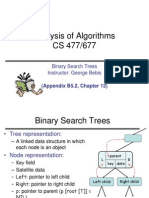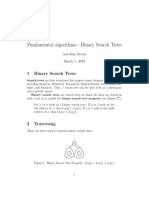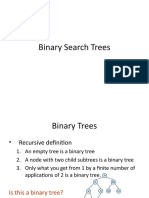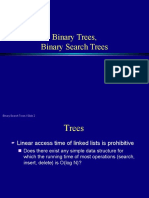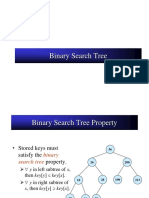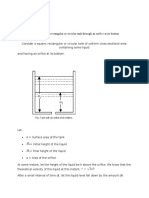Introduction to Data Structures and Algorithms
Chapter: Binary Search Trees
Lehrstuhl Informatik 7 (Prof. Dr.-Ing. Reinhard German) Martensstrae 3, 91058 Erlangen
�Binary Search Trees
Search Trees Search trees can be used to support dynamic sets, i.e. data structures that change during lifetime, where an ordering relation among the keys is defined. They support many operations, such as
SEARCH, MINIMUM, MAXIMUM, PREDECESSOR, SUCCESSOR, INSERT, DELETE.
The time that an operation takes depends on the height h of the tree.
Data Structures and Algorithms (153)
�Binary Search Trees
Binary Search Trees In the following we look at binary search trees a special kind of binary trees that support the mentioned operations on dynamic sets
Data Structures and Algorithms (154)
�Binary Search Trees
Binary Search Tree A binary tree is a binary search tree, if the following binary-search-tree property is satisfied: For any node x of the tree: If y is a node in the left subtree of x then key[y] key[x] If y is a node in the right subtree of x then key[y] key[x]
x y
y
Data Structures and Algorithms (155)
�Binary Search Trees
Examples of Binary Search Trees
7 22 10 7 21 40 51 21 22 The same set of keys
Data Structures and Algorithms (156)
10 40 51
�Binary Search Trees
Example: Printing the keys of a Binary Search Tree in ascending order
22 22 10 7 7 21 21 40 40 51 51
7 10 40 21 22
Data Structures and Algorithms (157)
51
�Binary Search Trees
Inorder tree walk Inorder_Tree_Walk prints the elements of a binary search tree in ascending order
Inorder_Tree_Walk(x) if x!=NIL then Inorder_Tree_Walk(left[x]) print(key[x]) Inorder_Tree_Walk(right[x]) For a tree T the initial call is Inorder_Tree_Walk(root[T])
Data Structures and Algorithms (158)
�Binary Search Trees
Inorder tree walk If x is the root of a binary (search) tree, the runtime of Inorder_Tree_Walk is (n) Intuitive explanation: after the initial call of Inorder_Tree_Walk the following is true: for each of the (n -1) not-NIL nodes of the tree there are exactly two calls of Inorder_Tree_Walk one for its left child and one for its right child (for details see [Corman])
Data Structures and Algorithms (159)
�Binary Search Trees
Searching for a node with given key k Recursive algorithm Tree_Search(x,k) if x=NIL or k=key[x] then return x if k<key[x] then return Tree_Search(left[x],k) else return Tree_Search(right[x],k) For a tree T the initial call for searching for key k is Inorder_Tree_Walk(root[T],k) Runtime of Tree_Search(x,k) is O(h) where h is the height of the tree
Data Structures and Algorithms (160)
�Binary Search Trees
Searching for a node with given key k Non-recursive algorithm Iterative_Tree_Search(x,k) while x!= NIL and k!= key[x] do if k<key[x] then x:= left[x] else x:= right[x] return x This non-recursive (iterative) version of tree-search is usually more efficient in practice since it avoids the runtime system overhead for recursion
Data Structures and Algorithms (161)
�Binary Search Trees
Searching for a node with given key Example Search for k = 31 Search for k = 3
22 10 7 15 9 18 27 31 30 33
32
Data Structures and Algorithms (162)
�Binary Search Trees
Minimum and maximum The element with minimum key value is always in the leftmost position of the binary search tree (not necessarily a leaf!) Tree_Minimum(x) while left[x]!=NIL do // left[x]=NIL no smaller element x := left[x] return x Runtime of TreeMinimum and TreeMaximum ist O(h) Remark: The pseudo code TreeMaximum for the maximum is analogous
Data Structures and Algorithms (163)
�Binary Search Trees
Minimum and maximum Example Search for Minimum
22 10 30 15 9 18 27 31 32 33
7 2
Data Structures and Algorithms (164)
�Binary Search Trees
Successor and predecessor If all keys are distinct, the successor (predecessor) of node x in sorted order is the node with the smallest key larger (smaller) than key[x] Tree_Successor(x) if right[x]!=NIL then return Tree_Minimum(right[x]) y := p[x] while y!=NIL and x=right[y] do x := y y := p[y] return[y]
Data Structures and Algorithms (165)
�Binary Search Trees
Successor and predecessor Remark: The pseudo code for Tree_Predescessor is analogous Runtime of Tree_Successor or Tree_Predecessor ist O(h) Because of the binary search property, for finding the successor or predecessor it is not necessary to compare the keys: We find the successor or predecessor because of the structure of the tree. So even if keys are not distinct, we define the successor (predecessor) of node x as the nodes returned by Tree_Successor(x) or Tree_Predeccessor(x).
Data Structures and Algorithms (166)
�Binary Search Trees
First summary On a binary search tree of heigth h, the dynamic-set operations SEARCH, MINIMUM, MAXIMUM, SUCCESSOR and PREDECESSOR can be implemented in time O(h)
Data Structures and Algorithms (167)
�Binary Search Trees
Insertion and deletion The operations of insertion and deletion change the dynamic set represented by a binary search tree If a new node is inserted into a binary search tree, or if a node is deleted, the structure of the tree has to be modified in such a way that the binary-search-tree property will still hold: A new node z to be inserted has fields left[z], right[z], p[z] = NIL key[z] = v The new node is always inserted as a leaf
Data Structures and Algorithms (168)
�Binary Search Trees
Insertion (pseudo code) Tree_Insert(T,z) y := NIL x := root[T] while x!=NIL do y := x if key[z]<key[x] then x := left[x] else x := right[x] p[z] := y if y=NIL then root[T] := z else if key[z]<key[y] then left[y] := z else right[y] := z
// Tree t was empty
Runtime of Tree_Insert: O(h)
Data Structures and Algorithms (169)
�Binary Search Trees
Insertion (example) a) Tree_Insert(T,z) (where key(z) = 14) b) Tree_Insert(T,z) (where key(z) = 39)
22 10 7 2 15 18 27 41 30 43
Data Structures and Algorithms (170)
�Binary Search Trees
Insertion (example) a) Tree_Insert(T,z) (where key(z) = 14) b) Tree_Insert(T,z) (where key(z) = 39)
22 10 7 2 14 15 18 39
Data Structures and Algorithms (171)
30 27 41 43
�Binary Search Trees
Deletion For deleting a node z from a binary search tree we can distinguish three cases
z is a leaf z has only one child z has two children
If z is a leaf, the leaf is simply deleted If z has only one child, then z is spliced out by making a new link from p[z] to the child of z If z has two children, then we first find its successor y (which has no left child!), then splice out y, and finally replace the contents of z (key and satellite data) by the contents of y.
Data Structures and Algorithms (172)
�Binary Search Trees
Deletion (pseudo code) Tree_Delete(T,z) if left[z]= NIL or right[z]= NIL then y := z else y := Tree_Successor(z) if left[y]!= NIL then x := left[y] else x := right[y] if x != NIL then p[x] := p[y] if p[y] = NIL then root[T] := x (go on next page)
Data Structures and Algorithms (173)
�Binary Search Trees
Deletion (pseudo code)
else if y = left[p[y]] then left[p[y]]:= x else right[p[y]]:= x if y != z then key[z] := key[y] (copy y`s satellite data into z) return y
The runtime of Tree_Delete is O(h)
Data Structures and Algorithms (174)
�Binary Search Trees
Analysis (results) Height of randomly built binary search trees with n nodes Best case: h = lg n Worst case: h = n 1 Average case behaviour: Expected height of a randomly built search tree with n modes = O(lg n)
Data Structures and Algorithms (175)
�Binary Search Trees
Analysis (results) If the tree is a complete binary tree with n nodes, then the worst-case time is (lg n). If the tree is very unbalanced (i.e. the tree is a linear chain), the worst-case time is (n). Luckily, the expected height of a randomly built binary search tree is O(lg n) basic operations take time (lg n) on average.
Data Structures and Algorithms (176)





